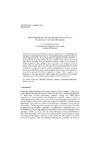Please use this identifier to cite or link to this item:
https://accedacris.ulpgc.es/handle/10553/59043
| DC Field | Value | Language |
|---|---|---|
| dc.contributor.author | Rodríguez Juárez, Carolina | en_US |
| dc.date.accessioned | 2019-12-17T15:59:12Z | - |
| dc.date.available | 2019-12-17T15:59:12Z | - |
| dc.date.issued | 2006 | en_US |
| dc.identifier.issn | 0210-6124 | en_US |
| dc.identifier.other | Dialnet | |
| dc.identifier.uri | https://accedacris.ulpgc.es/handle/10553/59043 | - |
| dc.description.abstract | The theoretical framework of Functional Grammar proposed by S. C. Dik highlights the relevance of implicational hierarchies for the different grammatical operations found in natural languages. In the case of the grammatical operation of Subject assignment, a group of priority hierarchies which predict the accessibility of term positions by virtue of their intrinsic properties have been claimed to directly impinge on the operation of Subject assignment. These typological hierarchies present term properties which are related to the term itself and to their referents. After balancing the postulates of Classical Dikkean Functional Grammar in general and the above-mentioned priority hierarchies in particular to a sampling of written material from the LOB Corpus, the main conclusion that emerges is that the internal structural complexity of the term must be recognised as a new relevant parameter for Subject assignment in English. Thus, I propose a new hierarchy, viz. the Term Hierarchy, which predicts the accessibility of term positions taking into account the internal structural complexity of the term in question. | en_US |
| dc.language | spa | en_US |
| dc.relation.ispartof | Atlantis | en_US |
| dc.source | Atlantis: Revista de la Asociación Española de Estudios Anglo-Norteamericanos [ISSN 0210-6124], v. 28 (1), p. 71-88 | en_US |
| dc.subject | 57 Lingüística | en_US |
| dc.subject.other | Accessibility | en_US |
| dc.subject.other | Functional (discourse) grammar | en_US |
| dc.subject.other | Implicational hierarchies | en_US |
| dc.subject.other | Subject assignment | en_US |
| dc.title | A new parameter for the description of subject assignment: the term hierarchy " | en_US |
| dc.type | info:eu-repo/semantics/Article | en_US |
| dc.type | Article | en_US |
| dc.identifier.scopus | 33749072606 | |
| dc.identifier.url | http://dialnet.unirioja.es/servlet/articulo?codigo=2521972 | - |
| dc.contributor.authorscopusid | 38261783800 | |
| dc.description.lastpage | 88 | - |
| dc.identifier.issue | 1 | - |
| dc.description.firstpage | 71 | - |
| dc.relation.volume | 28 | - |
| dc.investigacion | Artes y Humanidades | en_US |
| dc.type2 | Artículo | en_US |
| dc.contributor.authordialnetid | 299631 | - |
| dc.identifier.dialnet | 2521972ARTREV | - |
| dc.date.coverdate | Diciembre 2006 | |
| dc.identifier.ulpgc | Sí | es |
| dc.description.sellofecyt | Sello FECYT | |
| dc.description.ahci | AHCI | |
| dc.description.ssci | SSCI | |
| dc.description.erihplus | ERIH PLUS | |
| item.grantfulltext | open | - |
| item.fulltext | Con texto completo | - |
| crisitem.author.dept | GIR IATEXT: Variación y Cambio Lingüístico | - |
| crisitem.author.dept | IU de Análisis y Aplicaciones Textuales | - |
| crisitem.author.dept | Departamento de Filología Moderna, Traducción e Interpretación | - |
| crisitem.author.orcid | 0000-0001-6711-8597 | - |
| crisitem.author.parentorg | IU de Análisis y Aplicaciones Textuales | - |
| crisitem.author.fullName | Rodríguez Juárez, Carolina Fátima | - |
| Appears in Collections: | Artículos | |
Items in accedaCRIS are protected by copyright, with all rights reserved, unless otherwise indicated.
